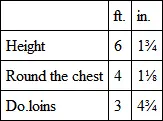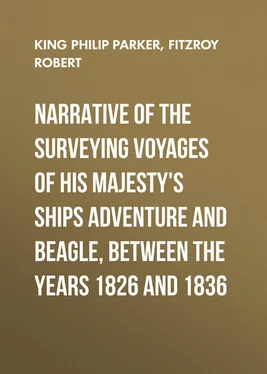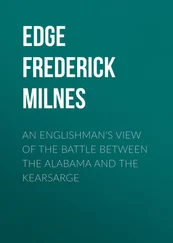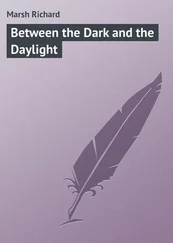Robert Fitzroy - Narrative of the surveying voyages of His Majesty's ships Adventure and Beagle, between the years 1826 and 1836
Здесь есть возможность читать онлайн «Robert Fitzroy - Narrative of the surveying voyages of His Majesty's ships Adventure and Beagle, between the years 1826 and 1836» — ознакомительный отрывок электронной книги совершенно бесплатно, а после прочтения отрывка купить полную версию. В некоторых случаях можно слушать аудио, скачать через торрент в формате fb2 и присутствует краткое содержание. Издательство: Иностранный паблик, Жанр: foreign_antique, foreign_prose, на английском языке. Описание произведения, (предисловие) а так же отзывы посетителей доступны на портале библиотеки ЛибКат.
- Название:Narrative of the surveying voyages of His Majesty's ships Adventure and Beagle, between the years 1826 and 1836
- Автор:
- Издательство:Иностранный паблик
- Жанр:
- Год:неизвестен
- ISBN:нет данных
- Рейтинг книги:3 / 5. Голосов: 1
-
Избранное:Добавить в избранное
- Отзывы:
-
Ваша оценка:
- 60
- 1
- 2
- 3
- 4
- 5
Narrative of the surveying voyages of His Majesty's ships Adventure and Beagle, between the years 1826 and 1836: краткое содержание, описание и аннотация
Предлагаем к чтению аннотацию, описание, краткое содержание или предисловие (зависит от того, что написал сам автор книги «Narrative of the surveying voyages of His Majesty's ships Adventure and Beagle, between the years 1826 and 1836»). Если вы не нашли необходимую информацию о книге — напишите в комментариях, мы постараемся отыскать её.
Narrative of the surveying voyages of His Majesty's ships Adventure and Beagle, between the years 1826 and 1836 — читать онлайн ознакомительный отрывок
Ниже представлен текст книги, разбитый по страницам. Система сохранения места последней прочитанной страницы, позволяет с удобством читать онлайн бесплатно книгу «Narrative of the surveying voyages of His Majesty's ships Adventure and Beagle, between the years 1826 and 1836», без необходимости каждый раз заново искать на чём Вы остановились. Поставьте закладку, и сможете в любой момент перейти на страницу, на которой закончили чтение.
Интервал:
Закладка:
We found eight or ten huts arranged in a row; the sides and backs were covered with skins, but the fronts, which faced the east, were open; even these, however, were very much screened from wind by the ridge of hills eastward of the plain. Near them the ground was rather bare, but a little farther back there was a luxuriant growth of grass, affording rich and plentiful pasture for the horses, among which we observed several mares in foal, and colts feeding and frisking by the side of their dams: the scene was lively and pleasing, and, for the moment, reminded me of distant climes, and days gone by.
The 'toldos' are all alike. In form they are rectangular, about ten or twelve feet long, ten deep, seven feet high in front, and six feet in the rear. The frame of the building is formed by poles stuck in the ground, having forked tops to hold cross pieces, on which are laid poles for rafters, to support the covering, which is made of skins of animals sewn together so as to be almost impervious to rain or wind. The posts and rafters, which are not easily procured, are carried from place to place in all their travelling excursions. Having reached their bivouac, and marked out a place with due regard to shelter from the wind, they dig holes with an iron bar or piece of pointed hard wood, to receive the posts; and all the frame and cover being ready, it takes but a short time to erect a dwelling. Their goods and furniture are placed on horseback under the charge of the females, who are mounted aloft upon them. The men carry nothing but the lasso and bolas, to be ready for the capture of animals, or for defence.
Maria's toldo was nearly in the middle, and next to it was her brother's. All the huts seemed well stored with skins and provisions, the former being rolled up and placed at the back, and the latter suspended from the supporters of the roof; the greater part was in that state well known in South America by the name of charque (jerked beef); but this was principally horse-flesh, which these people esteem superior to other food. The fresh meat was almost all guanaco. The only vessels they use for carrying water are bladders, and sufficiently disagreeable substitutes for drinking utensils they make: the Fuegian basket, although sometimes dirty, is less offensive.
About two hundred yards from the village the tomb was erected, to which, while Maria was arranging her skins and mantles for sale, the father of the deceased conducted me and a few other officers.
It was a conical pile of dried twigs and branches of bushes, about ten feet high and twenty-five in circumference at the base, the whole bound round with thongs of hide, and the top covered with a piece of red cloth, ornamented with brass studs, and surmounted by two poles, bearing red flags and a string of bells, which, moved by the wind, kept up a continual tinkling.
A ditch, about two feet wide and one foot deep, was dug round the tomb, except at the entrance, which had been filled up with bushes. In front of this entrance stood the stuffed skins of two horses, recently killed, each placed upon four poles for legs. The horses' heads were ornamented with brass studs, similar to those on the top of the tomb; and on the outer margin of the ditch were six poles, each carrying two flags, one over the other.
The father, who wept much when he visited the tomb, with the party of officers who first went with him, although now evidently distressed, entered into, what we supposed to be, a long account of the illness of his child, and explained to us that her death was caused by a bad cough. No watch was kept over the tomb; but it was in sight of, and not very far from their toldos, so that the approach of any one could immediately be known. They evidently placed extreme confidence in us, and therefore it would have been as unjust as impolitic to attempt an examination of its contents, or to ascertain what had been done with the body.
The Patagonian women are treated far more kindly by their husbands than the Fuegian; who are little better than slaves, subject to be beaten, and obliged to perform all the laborious offices of the family. The Patagonian females sit at home, grinding paint, drying and stretching skins, making and painting mantles. In travelling, however, they have the baggage and provisions in their charge, and, of course, their children. These women probably have employments of a more laborious nature than what we saw; but they cannot be compared with those of the Fuegians, who, excepting in the fight and chace, do every thing. They paddle the canoes, dive for shells and sea-eggs, build their wigwams, and keep up the fire; and if they neglect any of these duties, or incur the displeasure of their husbands in any way, they are struck or kicked most severely. Byron, in his narrative of the loss of the Wager, describes the brutal conduct of one of these Indians, who actually killed his child for a most trifling offence. The Patagonians are devotedly attached to their offspring. In infancy they are carried behind the saddle of the mother, within a sort of cradle, in which they are securely fixed. The cradle is made of wicker-work, about four feet long and one foot wide, roofed over with twigs like the frame of a tilted waggon. The child is swaddled up in skins, with the fur inwards or outwards according to the weather. At night, or when it rains, the cradle is covered with a skin that effectually keeps out the cold or rain. Seeing one of these cradles near a woman, I began to make a sketch of it, upon which the mother called the father, who watched me most attentively, and held the cradle in the position which I considered most advantageous for my sketch. The completion of the drawing gave them both great pleasure, and during the afternoon the father reminded me repeatedly of having painted his child ("pintado su hijo.")
One circumstance deserves to be noticed, as a proof of their good feeling towards us. It will be recollected that three Indians, of the party with whom we first communicated, accompanied us as far as Cape Negro, where they landed. Upon our arrival on this occasion, I was met, on landing, by one of them, who asked for my son, to whom they had taken a great fancy; upon my saying he was on board, the native presented me with a bunch of nine ostrich feathers, and then gave a similar present to every one in the boat. He still carried a large quantity under his arm, tied up in bunches, containing nine feathers in each; and soon afterwards, when a boat from the Beagle landed with Captain Stokes and others, he went to meet them; but finding strangers, he withdrew without making them any present.
In the evening my son landed, when the same Indian came down to meet him, appeared delighted to see him, and presented him with a bunch of feathers, of the same size as those which he had distributed in the morning. At this, our second visit, there were about fifty Patagonian men assembled, not one of whom looked more than fifty-five years of age. They were generally between five feet ten and six feet in height: one man only exceeded six feet – whose dimensions, measured by Captain Stokes, were as follows: —

I had before remarked the disproportionate largeness of head, and length of body of these people, as compared with the diminutive size of their extremities; and, on this visit, my opinion was further confirmed, for such appeared to be the general character of the whole tribe; and to this, perhaps, may be attributed the mistakes of some former navigators. Magalhaens, or rather Pigafetta, was the first who described the inhabitants of the southern extremity of America as giants. He met some at Port San Julian, of whom one is described to be "so tall, that our heads scarcely came up to his waist, and his voice was like that of a bull." Herrera, 71 71 Burney, i. p. 33.
however, gives a less extravagant account of them: he says, "the least of the men was larger and taller than the stoutest man of Castile;" and Maxim. Transylvanus says they were "in height ten palms or spans; or seven feet six inches."
Интервал:
Закладка:
Похожие книги на «Narrative of the surveying voyages of His Majesty's ships Adventure and Beagle, between the years 1826 and 1836»
Представляем Вашему вниманию похожие книги на «Narrative of the surveying voyages of His Majesty's ships Adventure and Beagle, between the years 1826 and 1836» списком для выбора. Мы отобрали схожую по названию и смыслу литературу в надежде предоставить читателям больше вариантов отыскать новые, интересные, ещё непрочитанные произведения.
Обсуждение, отзывы о книге «Narrative of the surveying voyages of His Majesty's ships Adventure and Beagle, between the years 1826 and 1836» и просто собственные мнения читателей. Оставьте ваши комментарии, напишите, что Вы думаете о произведении, его смысле или главных героях. Укажите что конкретно понравилось, а что нет, и почему Вы так считаете.












